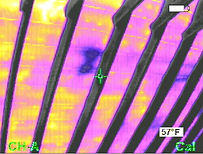INFRARED THERMAL IMAGING
Infrared Thermal Imaging (IR) Inspections will find the source of leaks and dampness or areas of heat loss. Some problems are not visible during a routine home inspection. However, an IR camera can detect "invisible" problems such as moisture, hot electrical wires, or termite and rodent nests making it an invaluable service for home buyers and sellers. One of the bigger issues facing a new home owner is discovering there is "hidden" and costly electrical or mold problems that must be addressed immediately. Additionally, many people putting their home on the market are unaware they have these problems. An IR inspection is an inexpensive way to detect problems that could end up costing thousands of dollars to repair. When the safety factor is figured in, an IR inspection is priceless.
During an IR inspection, we use an IR imaging and measurement camera to "see" and "measure" thermal energy emitted from an object. Thermal, or infrared energy, is light that is not visible because the wavelength is too long to be detected by the human eye and is part of the electromagnetic spectrum that we perceive as heat. Unlike visible light, in the infrared world everything having a temp-erature above absolute zero emits heat. The higher the object's temperature, the greater the IR radiation emitted. IR imaging allows us to see what our eyes cannot by producing images of invisible infrared or "heat" radiation providing precise temperature measurement. An infrared camera detects infrared energy (heat) by converting it into an electronic signal which is then processed to produce a thermal image while performing temperature calculations. Heat sensed by an infrared camera can be very precisely quantified, or measured, allowing you to not only monitor thermal performance but also identify and evaluate the relative severity of heat-related problems. Below are actual IR images from our archives. None of the damage was visible to the naked eye.
INFRARED THERMAL IMAGING PROVIDES:
Fast detection for quick action Moisture and mold location Sources of heat loss and energy inefficiency. An IR inspection will provide immediate documentation of plumbing and building envelope water leakage, energy use inefficiency, and electrical problems. Moisture in building materials can destroy structural integrity and nurture mold and insect infestations which, in turn, cause a variety of health problems. The first step in mold remediation is to quickly and accurately locate it. IR cameras can instantly take an image of an entire room, inspect places that can'’t be physically reached with moisture meters, reveal wet conditions behind surfaces such as enameled walls and wallpaper, track leaks to their source, monitor the drying process, and confirm when a structure is dry. IR thermography is a well accepted method of imaging and evaluating the thermal efficiency of building insulation, doors, windows and other penetrations, and the efficiency and condition of heating and cooling systems. Unexplained temperature irregularities are rendered visible, enabling needed repairs to be made with confidence.

Moisture damage in bedroom wall corner and ceiling in black; energy inefficient window shown in yellow.

Roof from attic: yellow shows areas of heat loss; dark spots in middle and to the far right show moisture damage and leakage.

Rodent tunnels, shown in white, surrounding ductwork behind wall in child's upstairs bedroom.
Richard D. Malin & Associates, Inc.
Home Inspections, Radon Testing, Infrared Thermal Imaging, Indoor Air Quality Testing
